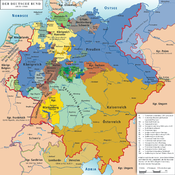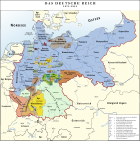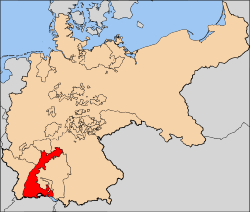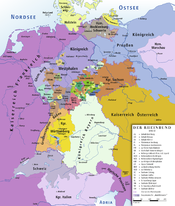- Grand Duchy of Baden
-
Grand Duchy of Baden
Großherzogtum Baden← 
←
1806–1918  →
→

Flag (1891–1918) Coat of arms Anthem
BadnerliedBaden, shown within the German Empire Capital Karlsruhe Language(s) Alemannic German Religion Protestant (after reunification in 1771) Government Monarchy Grand duke - 1771–1811
(first grand dukea)Charles Frederick - 1907–18
(last grand duke)Friedrich II (died 1928) Staatsminister - 1809–10 (first) Sigismund von Reitzenstein - 1917–18 (last) Heinrich von und zu Bodman Legislature Landtag - Upper house Erste Kammer - Lower house Zweiten Kammer History - Margraviate raised
to grand duchy
1806- Joined German Emp. 1871 - German Revolution November 14, 1918 Area - 1803 3,400 km2 (1,313 sq mi) - 1905 15,082 km2 (5,823 sq mi) Population - 1803 est. 210,000 Density 61.8 /km2 (160 /sq mi) - 1905 est. 2,009,320 Density 133.2 /km2 (345.1 /sq mi) Currency - Baden gulden (to 1873)
- Baden thaler (1829–37)
- Goldmark (1873–1914)
- Papiermark (from 1914)
a: Karl Friedrich was Margrave of Baden-Durlach from 1746–71, when he inherited Baden-Baden, becoming Margrave of unified Baden. In 1803, support for Napoleon saw him raised to Elector of Baden. He joined the Confederation of the Rhine in 1806, when he was raised to Grand Duke of Baden. The Grand Duchy of Baden (German: Großherzogtum Baden) was a historical state in the southwest of Germany, on the east bank of the Rhine. It existed between 1806 and 1918.
Contents
History
Main article: History of BadenBaden came into existence in the 12th century as the Margraviate of Baden and subsequently split into different lines, which were unified in 1771. In 1803 Baden was raised to Electoral dignity within the Holy Roman Empire. Baden became the much-enlarged Grand Duchy of Baden through the dissolution of the Holy Roman Empire in 1806. In 1815 it joined the German Confederation. During the Revolutions of 1848 in the German states, Baden was a center of revolutionist activities. In 1849 it was the only German state that became a republic for a short while, under the leadership of Lorenzo Brentano. Finally the revolution in Baden was suppressed mainly by Prussian troops.
The Grand Duchy of Baden remained a sovereign country until it joined the German Empire in 1871. After the revolution of 1918 Baden became part of the Weimar Republic as the Republic of Baden.
Constitution and Government
The Grand Duchy of Baden was a hereditary monarchy with executive power vested in the Grand Duke while the legislative authority was shared by him with a representative assembly (Landtag) consisting of two chambers.
The upper chamber included all the princes of the ruling family of full age, the heads of all the mediatized families, the Archbishop of Freiburg, the president of the Protestant Evangelical Church, a deputy from each of the universities and the technical high school, eight members elected by the territorial nobility for four years, three representatives elected by the chamber of commerce, two by that of agriculture, one by the trades, two mayors of municipalities, and eight members (two of them legal functionaries) nominated by the Grand Duke.
The lower chamber consisted of 73 popular representatives, of whom 24 were elected by the burgesses of certain communities, and 49 by rural communities. Every citizen of 25 years of age, who had not been convicted and was not a pauper, had a vote. The elections were, however, indirect. The citizens selected the Wahlmänner (deputy electors), the latter selecting the representatives. The chambers met at least every two years. The lower chambers were elected for four years, half the members retiring every two years.
The executive consisted of four departments: The interior, foreign and grand-ducal affairs, finance, and justice, and ecclesiastical affairs and education.
The chief sources of revenue were direct and indirect taxes, the railways and domains. The railways were operated by the state, and formed the only source of major public debt, about 22 million pounds sterling.
The supreme courts lay in Karlsruhe, Freiburg, Offenburg, Heidelberg, Mosbach, Waldshut, Konstanz, and Mannheim, whence appeals passed to the Reichsgericht (the supreme tribunal) in Leipzig.
Grand Dukes of Baden
- 1806–1811: Charles Frederick (* 1728; † 1811)
- 1811–1818: Charles (* 1786; † 1818)
- 1818–1830: Louis I (* 1763; † 1830)
- 1830–1852: Leopold (* 1790; † 1852)
- 1852–1858: Louis II (* 1824; † 1858)
- 1858–1907: Frederick I (* 1826; † 1907), (since 1852 Regent, since 1856 with the title Grand Duke)
- 1907–1918: Frederick II (* 1857; † 1928)
Minister of state 1809–1918
- 1809–1810: Sigismund von Reitzenstein
- 1810–1810: Conrad Karl Friedrich von Andlau-Birseck
- 1810–1812: Christian Heinrich Gayling von Altheim
- 1812–1817: Karl Christian von Berckheim
- 1817–1818: Sigismund von Reitzenstein
- 1818–1831: Wilhelm Ludwig Leopold Reinhard von Berstett
- 1832–1833: Sigismund von Reitzenstein
- 1833–1838: Ludwig Georg von Winter
- 1838–1839: Karl Friedrich Nebenius
- 1839–1843: Friedrich Landolin Karl von Blittersdorf
- 1843–1845: Christian Friedrich von Boeckh
- 1845–1846: Karl Friedrich Nebenius
- 1846–1848: Johann Baptist Bekk
- 1848–1849: Karl Georg Hoffmann
- 1849–1850: Friedrich Adolf Klüber
- 1850–1856: Ludwig Rüdt von Collenberg-Bödigheim
- 1856–1860: Franz von Stengel
- 1861–1866: Anton von Stabel
- 1866–1868: Karl Mathy
- 1868–1876: Julius Jolly
- 1876–1893: Ludwig Karl Friedrich Turban
- 1893–1901: Franz Wilhelm Nokk
- 1901–1905: Carl Ludwig Wilhelm Arthur von Brauer
- 1905–1917: Alexander von Dusch
- 1917–1918: Heinrich von Bodman
See also
- Baden, for the pre-19th century state
- Baden-Württemberg, for the modern German federal state
- History of Baden
- Coat of arms of Baden
- Republic of Baden, for the state that existed from 1918–1945
- Rulers of Baden, for a list of sovereigns and presidents
- Revolutions of 1848 in the German states
- Freiwilliges Feldjäger-Korps von Schmidt
References
 States of the Confederation of the Rhine (1806–13)
States of the Confederation of the Rhine (1806–13)Rank elevated
by NapoleonKingdomsGrand DuchiesBaden · HesseStates created KingdomsGrand DuchiesPrincipalitiesPre-existing
statesDuchiesAnhalt (Bernburg · Dessau · Köthen) · Arenberg · Mecklenburg (Schwerin · Strelitz) · Nassau · Oldenburg · Saxony (Coburg-Saalfeld · Gotha-Altenburg · Hildburghausen · Meiningen · Weimar3 · Eisenach3 · Weimar-Eisenach4)PrincipalitiesHohenzollern (Hechingen · Sigmaringen) · Isenburg-Birstein · Liechtenstein · Lippe-Detmold · Reuss (Ebersdorf · Greiz · Lobenstein · Schleiz) · Salm5 · Schaumburg-Lippe · Schwarzburg (Rudolstadt · Sondershausen) · Waldeck1 from 1810. 2 until 1810. 3 until 1809. 4 from 1809. 5 until 1811. States of the German Confederation (1815–66)
States of the German Confederation (1815–66)Empires 
Kingdoms Electorates Grand Duchies Duchies Anhalt (Bernburg2 · Dessau2 · Köthen3) · Brunswick · Holstein · Limburg4 · Nassau · Saxe-Lauenburg · Saxony (Altenburg5 · Coburg-Saalfeld6 · Coburg-Gotha5 · Gotha-Altenburg6 · Hildburghausen6 · Meiningen)Principalities Hesse-Homburg · Hohenzollern (Hechingen7 · Sigmaringen7) · Liechtenstein · Lippe · Reuss (Elder · Junior) · Schaumburg-Lippe · Schwarzburg (Rudolstadt · Sondershausen) · Waldeck and PyrmontCity-states Other territories
outside of the
confederacyColonial possessions · Personal unions of Habsburg (Bukovina · Croatia · Galicia and Lodomeria · Hungary · Lombardy–Venetia · Serbian Voivodeship and Banat8 · Slavonia9 · Transylvania) · Personal union of Hanover (Great Britain and Ireland10) · Personal unions of Hohenzollern (East Prussia11 · Neuchâtel12 · Posen, Gr. Duchy13 · Posen, Prov.14 · Prussia, Prov.15 · West Prussia11) · Occupied: Schleswig161 w/o areas listed under other territories. 2 Merged with Anhalt from 1863. 3 until 1847. 4 from 1839. 5 from 1826. 6 until 1826. 7 until 1850. 8 1849–60. 9 as of 1849. 10 until 1837. 11 until 1829. 12 until 1848/57. 13 until 1848. 14 as of 1848. 15 as of 1829. 16 as of 1864. States of the German Empire (1871–1918)
States of the German Empire (1871–1918)Kingdoms 
Grand Duchies Duchies Anhalt · Brunswick · Saxe-Altenburg · Saxe-Coburg and Gotha · Saxe-Lauenburg (until 1876) · Saxe-MeiningenPrincipalities Schaumburg-Lippe · Schwarzburg-Rudolstadt · Schwarzburg-Sondershausen · Lippe · Reuss Elder Line · Reuss Junior Line · Waldeck-PyrmontCity-states Other territories Elsaß-Lothringen · Colonial possessionsSigismund Freiherr von Reitzenstein | Conrad Karl Friedrich Freiherr von Andlau-Birseck | Christian Heinrich Freiherr Gayling von Altheim | Karl Christian Freiherr von Berckheim | Sigismund Freiherr von Reitzenstein | Wilhelm Ludwig Leopold Reinhard Freiherr von Berstett | Sigismund Freiherr von Reitzenstein | Ludwig Georg von Winter | Karl Friedrich Nebenius | Friedrich Landolin Karl Freiherr von Blittersdorf | Christian Friedrich von Boeckh | Karl Friedrich Nebenius | Johann Baptist Bekk | Karl Georg Hoffmann | Friedrich Adolf Klüber | Franz Freiherr von Stengel | Anton von Stabel | Karl Mathy | Julius Jolly | Ludwig Karl Friedrich Turban | Wilhelm Nokk | Arthur von Brauer | Alexander Freiherr von Dusch | Heinrich Freiherr von und zu BodmanCategories:- Former monarchies of Europe
- Former countries in Europe
- States and territories established in 1806
- States and territories disestablished in 1918
- 1918 disestablishments
- Baden
- History of Baden-Württemberg
- States of the German Empire
- States of the German Confederation
- States of the Confederation of the Rhine
Wikimedia Foundation. 2010.




